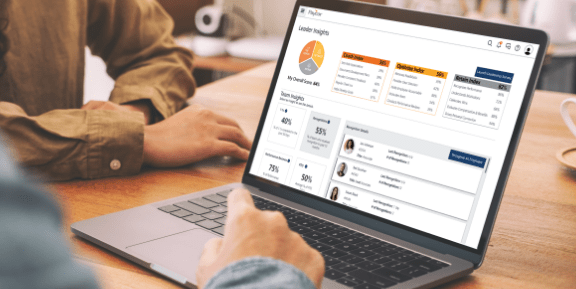If you run payroll for a business, then you’re familiar with payroll reports. These multi-faceted tools are integral to accurate employee payments, tax filing, auditing, and so much more. Essentially, a detailed payroll report serves as the backbone of financial transparency and regulatory compliance for a business.
Read on to learn more about payroll reports and the many benefits they have for a business.
What is a Payroll Report?

Once the process of running payroll ends, the financial data related to employee compensation becomes available in a comprehensive summary: a payroll report or pay report. Some of the data includes gross wages, net pay, employer contributions, and, of course, any deductions from the gross pay, such as taxes and benefits.
At its core, a payroll report helps businesses take raw data and turn it into actionable data, such as tracking labor costs and meeting legal obligations. These reports can be used to prepare tax filings and reconcile bank statements, not to mention that the essential data helps with budgeting, auditing, and more.
Why Are Payroll Reports Important?
Payroll reports play a key role in helping businesses meet compliance obligations across different tax jurisdictions. They also provide the kind of accurate financial data that’s essential for budgeting and forecasting. For example, if a company is thinking about expanding, payroll reports help clarify the potential costs involved—like how much more will be spent on salaries for new hires, or what it might take to finance a bigger office or new location.
Beyond these core uses, there are several other reasons payroll reports matter so much to a business:
- Ensuring Tax Compliance: Precise figures provided for accurate and timely filing of local, state, and federal payroll taxes (e.g., Forms 941, W-2s, and state unemployment taxes).
- Financial Accuracy and Reconciliation: Detailed breakdowns on wage and deduction activity to facilitate reconciling bank statements and general ledger accounts
- Budgeting and Forecasting: Clear insights into labor costs such as wages, overtime, and employer-paid benefits make financial planning, budgeting, and forecasting more effective.
- Audit Preparedness: Well-maintained payroll reports serve as verifiable documentation of compliance and financial integrity, which streamlines the payroll audit process.
- Employee Information Verification: Reliable records for employee earnings, deductions, and contributions are crucial for when discrepancies require resolution.
Benefits of Creating Payroll Reports

There is no downside to a creating payroll reports, letting the data work in your favor to benefit your business. Here are some of the best benefits:
Enhanced Financial Control
Maintaining a clear, historical record of payroll expenses allows employers to accurately forecast salary increases, payroll taxes, and benefit changes, while automated payroll reporting further streamlines processes by reducing manual data entry. Together, these practices help minimize errors, save time, and make managing payroll more efficient and predictable.
Ensured Regulatory Compliance
Payroll reports provide the essential data needed for timely and accurate filing of federal, state, and local payroll taxes, which helps reduce the risk of costly errors and penalties. By ensuring filings are correct and submitted on time, employers can avoid time-consuming audits and significant fines from tax authorities.
Improved Strategy and Efficiency
Payroll reports offer valuable data-driven insights that help businesses make informed decisions about workforce costs, staffing levels, and resource allocation. By highlighting trends in salaries, bonuses, and turnover, these reports support more effective workforce planning and budgeting.
Types of Payroll Reports
There are dozens of payroll reports, but this article focuses on the 15 payroll reports business use the most:
1. Payroll Summary Reports
A payroll summary report gives a concise snapshot of a company’s payroll activity for a set period—typically a week, month, or quarter. Instead of listing each employee’s details, it combines the main numbers: total gross wages, total deductions, and total net pay distributed.
For businesses, this report is a central tool for tracking labor costs and managing finances. It helps with budgeting, forecasting cash flow, and making sure payroll expenses match up with the general ledger. This kind of clarity is essential for accurate tax filings, audits, and overall financial planning.
2. Federal Payroll Reports
A federal payroll report is legally mandated by the IRS, so an integral part of any employer’s compliance obligations. Form 941 and annual W-2s are prime examples of these documents that detail employee compensation, federal tax withholdings, and employer contributions – covering everything from income, Social Security, and Medicare withholdings to FUTA.
From a business standpoint, employers can use the financial insights to budget and forecast based on the accurate tracking of labor costs. These reports also with identifying potential discrepancies while minimizing the risk of non-compliance errors that could result in costly penalties from the IRS.
The lifeblood of any business is its financial health, and federal payroll reports such as an employer’s quarterly federal tax return (Form 941) and annual W2 (wage and tax statement) give HR departments insights to make informed decisions on personnel expenses ranging from employee payments, tracking paid time off, and managing benefits.
3. State Payroll Reports
State payroll reports, like federal payroll reports, give an overview of employee wages and compensation specific to a state. That’s where the similarities end. State reports vary significantly from one another, plus include details on state income tax withholdings, unemployment insurance (UI) contributions, and workers’ compensation data.
A few examples of state payroll reports are New York’s Form NYS-45 (Quarterly Combined Withholding, Wage Reporting, and Unemployment Insurance Return) and California’s Form DE-4 (Employee’s Withholding Allowance Certificate).
Businesses often file these quarterly but, depending on the size of the payroll, additional periodic remittances sometimes are required.
Filing state payroll reports enables businesses to maintain compliance with state-specific labor and tax laws, avoid penalties, and any potential legal issues from miscalculations.
For HR, maintaining accurate state payroll reporting ensures employees are paid correctly according to state minimum wage and overtime laws, plus these reports facilitate proper benefits administration (e.g., state-mandated paid sick leave), and provide data on labor costs that is crucial to workforce planning.
From a financial standpoint, state payroll reports help minimize audit risks, enable precise budgeting, and optimize cash flow by accurately managing state tax liabilities and unemployment insurance premiums.
4. Local Payroll Reports
A local payroll report, which is mandated by city, county, or other municipal jurisdictions, could include local income tax withholdings, specific local levies (e.g., occupational privilege taxes), or unique local contributions such as in New York City where employers must withhold local income tax for residents.
With such diverse local tax ordinances, local payroll reports help businesses remain compliant and avoid penalties and fines. With such granular data, an employer with multiple localities can conduct precise local budgeting and expense tracking. HR departments rely on these reports to ensure accurate employee paychecks adhere to local wage laws, manage locality-specific deductions, and maintain compliance with local labor regulations.
Local payroll reports help businesses improve their financial stability by mitigating legal risks, optimizing local tax payments, and enhancing financial transparency.
5. Annual Payroll Report
What would year-end be without annual payroll reports with summaries of the entire year’s compensation data (gross wages, withheld taxes from federal, state, and local level) and employer contributions (FUTA, SUI)? Several of the most-common examples are Form W-2 for employees and Form 940 filed with the IRS, which usually are due by Jan. 31 of the following year.
Annual payroll reports help businesses accurately file year-end taxes, and timely delivery ensures compliance with federal and state regulations and the avoidance of penalties. The comprehensive financial overview is helpful with budgeting, identifying labor costs, and overall strategic planning.
On the HR side, annual payroll reports are instrumental in verifying employee earnings for benefits and retirement plans, which also helps with analyzing compensation structures and ensuring fair pay practices. This ultimately might contribute to employee retention.
6. Quarterly Payroll Report
With details on wages paid, federal income tax withheld, plus contributions from employees and employer through Social Security and Medicare taxes, a quarterly payroll report provides a three-month summary of a business’s payroll activity. Form 941 is the most common of the quarterly payroll reports, which is due the last day of the month following the end of each quarter.
These reports provide a financial snapshot, so businesses might better adjust budgeting and cash flow management related to labor costs on a regular basis.
Quarterly payroll reports enable an HR department to track employee earnings, manage benefits deductions, verify payroll accuracy, and even monitor compliance with wage and hours laws.
7. Payroll Tax Reports
All taxes employers are legally required to withhold from employee wages – federal income tax, Social Security and Medicare (FICA), federal and state unemployment (FUTA and SUTA) – that must be paid on their own behalf are available in a payroll tax report. These reports vary by jurisdiction and filing frequency; some are quarterly (Form 941) and others annually (W2s).
A payroll tax report, which is a summary of labor-related tax liabilities, helps businesses with budgeting and cash flow management, while HR staff utilize them to verify correct tax withholdings and manage employee deductions. These reports are critical to ensure compliance with complex tax laws.
8. Deduction Reports
For a complete breakdown of every tax pulled from an employee’s paycheck, an employer need look no further than a deduction report. This itemized report of withholdings required by law includes federal, state, and local income taxes, as well as Social Security and Medicare. There also are voluntary deductions such as health insurance premiums and retirement plan contributions).
A deduction report is key to helping businesses with accurate withholding and remittance to the proper agencies, which assists with fulfilling compliance obligations.
These reports help track benefit costs, reconcile payroll expenses, and assist by providing a clear trail during internal and external audits.
HR departments benefit from the transparency deduction reports offer in verifying that all mandatory and voluntary deductions are applied correctly. Additionally, employee inquiries about deductions (e.g., garnishments, other withholdings) are more efficiently answered with the help of the report.
9. Retirement Contribution Reports
Businesses trying to maintain compliance with the complex regulations from the IRS related to contribution limits and plan rules get an assist from a retirement contribution report. This report details all payments – current, month-, quarter-, and year-to-date accumulations for employee contributions, employer matches, and loan balances – into a 401(k), 403(b), or other deferred compensation plans.
By using a retirement contribution report to help stay compliant, businesses avoid avoiding penalties and maintain the tax-advantaged status of the plans. For HR, a retirement contribution report is essential for communicating to employees about their retirement benefits and verifying employee and employer contributions are processed correctly and on time.
10. Service Charge Reports
A detailed breakdown of all fees and expenses – payroll processing, tax filings, direct deposits, and any add-on services – associated with the use of a third-party payroll service provider are found on a service charge report.
For a business, this report can help with cost management by showing the actual financial impact of outsourcing payroll. It’s a great resource when budgeting payroll expenses and comparing pricing. HR staffs using insights from these reports can allocate resources and negotiate contracts with a better eye toward alignment with current and future needs while contributing to the company’s financial health.
11. PTO Payroll Reports
A PTO (paid time off) payroll report allows businesses to conduct accurate financial planning, manage labor costs, and prevent labor shortages by providing insights based on tracked employee leave balances (e.g., vacation, sick leave, etc.). The report has details on each employees’ accrued time, time used, and time remaining balances over a specified period (PeopleManagingPeople).
With turnover always an issue, HR departments might use PTO payroll reports to identify potential burnout risks and to enforce leave policies more consistently, among other options, because data around fair and accurate tracking reduces disputes and elevates employee satisfaction and retention.
12. Time and Attendance Reports
A time and attendance report contains data that is key to calculating accurate pay mainly for hourly and non-exempt employees. TAA reports, also referred to as wage and hour reports, are an accurate recording of employment work hours (regular, overtime, various paid and unpaid leave) that are critical for businesses to manage labor costs and ensure compliance with the Fair Labor Standards Act (FLSA).
Owners use these reports to identify overtime costs, giving them insights on proper staffing levels and helping to control their budgeting. For HR staffs, the value of a wage and hour report is in enforcing attendance policies and identifying staffing patterns
13. Workers’ Compensation Reports
No one wants to overpay for insurance costs. It’s a cash flow killer. A workers’ compensation report helps businesses manage insurance costs by providing detailed data on employee wages, hours worked, and job classifications that go into calculating workers’ comp insurance premiums. This means premiums are based on actual risks and not estimations. These reports are crucial documentation to present to insurance carriers during audits.
Workers’ compensation reports help HR departments protect the financial well-being of a business. Maintained accurate employee records (e.g., job duties and wages) directly affect insurance rates, while serving as a proper documentation for work-related injuries that assist with managing claims.
14. Incentive Program Reports
Businesses that uses sales commissions, profit-sharing, and bonuses – and measure the ROI of these and other incentives – will benefit from the data on a payroll incentive program report. These reports track the effectiveness of compensations structures designed to motivate and align employee performance with company goals. The report helps leaders evaluate compensation programs to better drive desire behaviors such as improved sales and increased productivity.
It’s a good way for businesses to identify cost-effective reward strategies or forecast the cost of labor associated with performance.
HR can use data from a report to ensure transparency in compensation, as well as to tweak incentive structures that could better motivate employees, especially if assessing the numbers reveals employee engagement and retention goals are not being met (Tango Card).
15. Certified Payroll Reports
Contractors and subcontractors who work on federally funded or assisted construction projects are required to produce a weekly certified payroll report. This report has details including worker’s names, hours worked, pay rate, job classification, gross and net wages, deductions, and fringe benefits. In addition to the report is a statement of compliance that certifies prevailing wages and benefits are paid.
Businesses who want to maintain eligibility for government contracts and avoid substantial penalties such as fines and project disqualification must demonstrate compliance regarding prevailing wage laws on their certified payroll reports.
For an HR department, a certified payroll report represents adherence to transparency and compliance regarding employee classification and managing complex wage structures, which demonstrates to the government that your business is trustworthy.
Mandatory Payroll Reports
There are several, mandatory forms to file at the federal and state level, each with a specific purpose, including the following:
Form 941
The Employer’s Quarterly Federal Tax Return – Form 941 – must be filed by most businesses that have employees every quarter. In contains federal income tax, Social Security, and Medicare taxes withheld from employee paychecks, as well as the employer’s share of Social Security and Medicare taxes. The IRS requires it to be filed to remain compliant with its regulations.
Form W-2
The Wage and Tax Statement (W-2) is an annual document issued to employees and the IRS by employers, reporting an employee’s yearly wages and the federal, state, and local taxes withheld. It must be filed by Jan. 31 so employees might accurately file their personal income tax returns.
Form W-3
This annual document, also known as the Transmittal of Wage and Tax Statement, is filed by employers with the Social Security Administration (SSA). It aggregates the total wages, tips, and other compensation, along with the total federal income, Social Security, and Medicare taxes withheld from all employees as reported on their individual W-2 forms. It must be filed by Jan. 31. All Copy A W-2s also must be filed to ensure the SSA has a complete record of employer-reported earnings and tax withholdings.
Forms 1099 and 1096
These forms are used to report non-employment income to the IRS.
Form 1099 (including 1099-NEC, 1099-MISC, 1099-K)
1099 forms report income paid to individuals or businesses who are not employees (e.g., independent contractors, landlords).
For example, a Form 1099-NEC reports payments to a freelancer. They must be filed by businesses and payers by Jan. 31 (or later for some types). A 1099-K is used to report income paid through a third-party vendor such as PayPal or Venmo.
Form 1096 (Annual Summary and Transmittal of U.S. Information Returns)
This is a cover sheet filed with paper copies of various 1099 and other information returns that summarizes the totals for each type of attached form. It must be filed by Jan. 31 (or later, depending on the attached forms’ due dates). Electronic filers do not submit Form 1096.
Form 940
The Employer’s Annual Federal Unemployment (FUTA) Tax Return reports the federal unemployment tax employers pay to fund compensation for eligible workers who have lost their jobs. It must be filed annually by Jan. 31 (or Feb. 10 if all FUTA tax was deposited on time) to ensure compliance with the Federal Unemployment Tax Act.
How to Get the Most Out of Your Payroll Reports
Payroll reports are more than just paperwork—they’re your first line of defense against costly mistakes and compliance headaches. Here’s how to use them to minimize risk:
Ensure Regulation Compliance
Stay on top of federal, state, and local rules. Use payroll reports to double-check that tax filings are accurate and deadlines aren’t missed. This keeps you out of trouble with auditors and avoids expensive penalties.
Verify Data Accuracy Regularly
Don’t take numbers at face value. Cross-check payroll figures with original records and timecards. Catching errors early means fewer fixes down the road and less risk of under- or overpaying your team.
Monitor Labor Costs and Trends
Review payroll reports to spot spikes in overtime, bonuses, or benefit costs. Tracking these trends helps you plan ahead—and keeps budget surprises to a minimum.
Identify and Prevent Fraud
Payroll reports can reveal red flags, like duplicate payments or unexpected changes in pay. Regularly reviewing them helps catch fraud before it turns into a bigger issue.
Communicate Findings to Stakeholders
Don’t keep payroll insights to yourself. Share important findings with management, HR, and finance so everyone’s on the same page and risks are easier to spot.
Use Payroll Software
Modern payroll systems automate calculations, flag inconsistencies, and help with reporting. They also streamline compliance and records management, making errors (and fraud) less likely.
Maintain a Secure System
Protect payroll data with strong passwords, regular software updates, and restricted access. A secure system keeps sensitive employee info safe and reduces your risk if there’s ever a cyberattack.
Automate Reporting Whenever Possible
Automated reporting features in your payroll system saves time, reduces manual errors, and ensures reports are generated consistently.
Maintain a Secure and Organized Filing System
Detailed payroll reports contain personal and sensitive data, so businesses should keep reports secure by adhering to data retention policies. Plus, organized reports make for easy retrieval for audit purposes.
How Paycor Helps You with Payroll Reports
Paycor gives HR leaders a powerful, all-in-one platform for payroll management and reporting. From time tracking and tax calculations to direct deposits, everything happens in one place. With customizable dashboards and an AI Analytics Assistant, HR teams can get real-time insights into labor costs, overtime, and pay trends. The platform makes it easy to spot patterns, predict turnover risks, and monitor pay equity.
Detailed payroll reports also help businesses stay compliant with changing tax laws and labor rules, reducing the risk of errors and audits. Paycor’s integrated system means you get accurate filings and the data you need to make better decisions, all while saving time on payroll tasks.
Here are a few reports you can create:
- Pre-post Payroll Journal
- Pre-post Employee Export
- Pay Run Audit Export
- Cash Requirements
- Labor Distribution
- Deductions Not Taken
- Unpaid Employees
Create Payroll Reports with Paycor

If you’re trying to stay on top of labor costs, staffing, or even planning to expand your business but need more data to identify trends and accurately forecast, look no further than Paycor. Our payroll solution offers detailed reporting capabilities and stress-free tax compliance. Take a guided tour of our products to learn how the payroll software can help.









